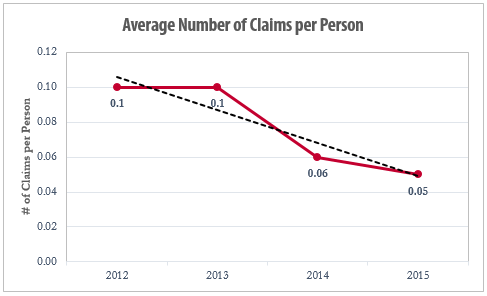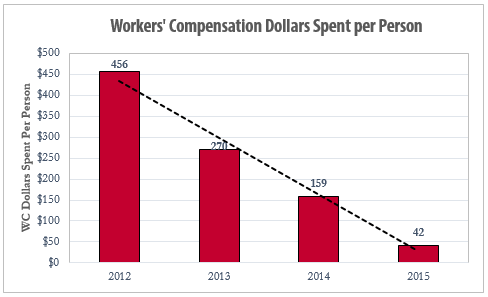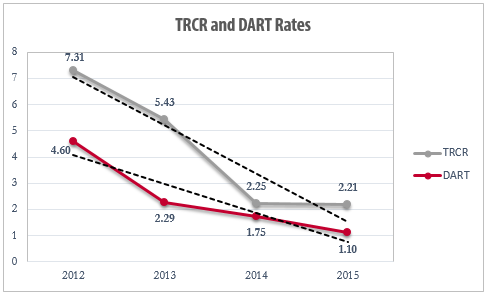Program Description
Although the Occupational Safety and Health Act of 1970 requires employers to provide workplaces “free from recognized hazards that are causing or likely to cause death or serious physical harm”1 to their workers, the toll of workplace injuries, illnesses and fatalities in the United States remains unacceptably high. According to a news release published by the Bureau of Labor Statistics (BLS) “there were approximately 2.9 million nonfatal workplace injuries and illnesses reported by private industry employers in 2015,” and over half involved at least one day away from work, a job transfer or a work restriction for recovery.2 The impact these injuries have on employers is staggering. “In its 2016 Workplace Safety Index, Liberty Mutual estimated that employers paid more than $1 billion per week for direct workers’ compensation costs for the most disabling workplace injuries and illnesses in 2013.”3 As the 2015 article from the Occupational Health and Safety Administration (OSHA) points out, however, the true impact lies with those suffering from these injuries. For working families already struggling to meet basic necessities and set aside some savings, a work injury to a primary wage earner can be especially devastating. There are also less tangible effects that are important but more difficult to monetize. Workplace injuries can diminish self-esteem and self-confidence and increase stress.4 The most effective solution for diminishing workers’ compensation costs and, more importantly, preserving the health and well-being of workers, is to focus on injury and illness prevention in the workplace.Facility Demographics
1 shiftNon-union350 employees
History On-Site
In 2012, a busy electrical manufacturing company was quickly outgrowing the safety practices that had once protected its people so well. Leadership needed a way to reduce workplace injuries and get a handle on rising workers’ compensation costs. Delayed reporting of chronic issues coupled with failure to report injuries until after treatment from outside providers were resulting in unnecessary clinic visits, treatments, high costs, and a climbing number of workers’ compensation claims from serious injuries. The company looked to AWS for an answer.
AWS Objectives
The ATI Worksite Solutions model offers a unique and comprehensive approach to total worker health. Certified Early Intervention Specialists (CEISs) are trained to focus on:
Loss Prevention – Recognize near miss opportunities related to posture, technique, and body mechanics. Coach employees on better, safer methods and ultimately avoid potential injury.
Prompt Medical Attention – Provide a boots-to-the floor approach. When an employee has an injury, the CEIS can evaluate and triage the injury on the plant floor. The CEIS manages minor musculoskeletal complaints in-house. This maintains productivity and eliminates unnecessary clinic visits.
Active Management of Injuries – Available to work with the employee through all stages of an injury and provide on-the-floor follow up and training. The CEIS can expedite care when the employee is not responding to first aid treatment to avoid delays and further injury.
Safe, Timely and Effective Return-To-Work – Play an active role in evaluating an employee’s ability to return to work. The CEIS can make recommendations for accommodations and transitional work to ensure the employee re-enters production safely and effectively thus decreasing lost time and lost productivity.
Root Cause Analysis – Use their unique understanding of body mechanics and injury progression to identify the true root cause of injury, as well as any irritants, and provides useful and innovative solutions for eliminating the hazards.
Results Achieved
AWS support was focused on the development of an improved safety culture in the plant by reducing the frequency and severity of injury. Success with these efforts was measured through workers’ compensation data and OSHA serious injury data. The site was successful at decreasing workers’ compensations costs per employee by greater than 90% and lowering the number of claims per person by 68%. Also, worker safety was improved dramatically with a 75% decrease in the site TRCR and a 79% decrease in DART cases.


References
Occupational Safety and Health Act of 1970, 29 U.S.C. 651-678. Retrieved from the Occupational Health and Safety Administration Database
Bureau of Labor Statistics. (2016). Employer-Reported Workplace Injuries and Illnesses – 2015 [Press release]. Retrieved from: Here
United States Department of Labor (2016). Business Case for Safety and Health. Occupational Health & Safety Administration. Retrieved from: Here
Michaels, David (2015, June). Adding Inequality to Injury: The Cost of Failing to Protect Workers on the Job. Occupational Health & Safety Administration. Retrieved from: Here

